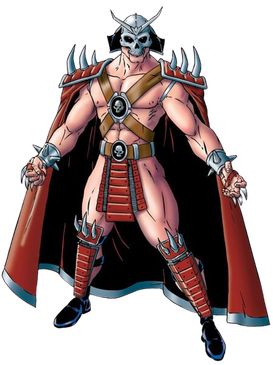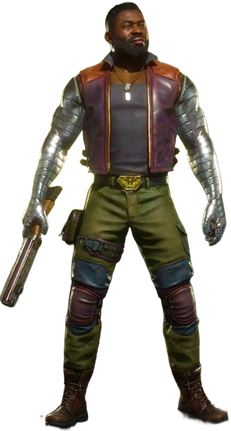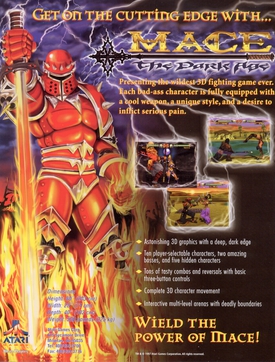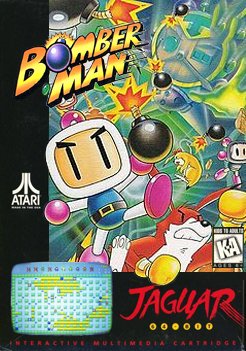
Mortal Kombat 4 is the fourth main installment in the Mortal Kombat series of fighting games developed by Midway Games. Released to arcades in 1997, Mortal Kombat 4 is the first title from the series, and one of the first made by Midway overall, to use 3D computer graphics. It is also the last game of the series to have an arcade release. It was later ported to the PlayStation, Nintendo 64, PC, and Game Boy Color the following year, as well as an updated version titled Mortal Kombat Gold released exclusively for the Dreamcast.

Shao Kahn is a fictional character in the Mortal Kombat fighting game franchise by Midway Games and NetherRealm Studios. Depicted as emperor of the fictional realm Outworld, he is one of the franchise's primary villains. Feared for his immense strength, which he complements with a large hammer, and knowledge of black magic, Shao Kahn seeks conquest of all the realms, including Earth. He serves as the main antagonist final boss of Mortal Kombat II (1993), Mortal Kombat 3 (1995) and its updates, and the 2011 reboot, as well as the action-adventure spin-off Mortal Kombat: Shaolin Monks (2005). An amalgam of Shao Kahn and DC Comics villain Darkseid also appears as the main antagonist and final boss of Mortal Kombat vs. DC Universe (2008) under the name Dark Kahn. A younger persona known as General Shao appears in Mortal Kombat 1 (2023).

Shang Tsung is a fictional character in the Mortal Kombat fighting game franchise by Midway Games and NetherRealm Studios. He debuted as the final boss in the original 1992 game and has remained one of the franchise's primary characters. A powerful sorcerer, he is principally defined by his abilities to shapeshift into other characters and to absorb the souls of defeated warriors. Shang Tsung is usually portrayed as the right-hand man of Outworld emperor Shao Kahn and the archenemy of Shaolin monk Liu Kang. He also appeared in Mortal Kombat: Deadly Alliance (2002), alongside Quan Chi as the eponymous Deadly Alliance, as well as in Mortal Kombat 11: Aftermath (2020) and Mortal Kombat 1 (2023).

Mileena is a character in the Mortal Kombat fighting game franchise by Midway Games and NetherRealm Studios. Introduced in Mortal Kombat II (1993), Mileena was initially depicted as a clone of the Edenian princess Kitana, created by Shang Tsung with the blood of the fictional Tarkatan species. Following the time-travelling actions of Raiden in Mortal Kombat 9 (2011), Mileena's background as a clone of Kitana remains the same. Mortal Kombat X (2015) depicts Mileena's attempts to regain the throne as the empress of Outworld, following her removal by Kotal Kahn.

Ermac is a character in the Mortal Kombat fighting game franchise by Midway Games and NetherRealm Studios. Debuting as an unlockable character in Ultimate Mortal Kombat 3 (1995), he is an amalgam of the souls of deceased warriors and possesses telekinetic abilities.

This is a list of playable and boss characters from the Mortal Kombat fighting game franchise and the games in which they appear. Created by Ed Boon and John Tobias, the series depicts conflicts between various realms. Most characters fight on behalf of their realm, with the primary heroes defending Earthrealm against conquering villains from Outworld and the Netherrealm. Early installments feature the characters participating in the eponymous Mortal Kombat tournament to decide their realm's fate. In later installments, Earthrealm is often invaded by force.

Jackson "Jax" Briggs is a fictional character in the Mortal Kombat fighting game franchise by Midway Games and NetherRealm Studios. Introduced in Mortal Kombat II (1993) as the leader of a Special Forces unit, he became a mainstay of the series, including as the protagonist of the action-adventure spin-off Mortal Kombat: Special Forces (2000). The character is distinguished by his metal bionic arms, which he first received in Mortal Kombat 3 (1995), and his abilities are based around his upper-body strength.

Kitana is a fictional character in the Mortal Kombat media franchise originally by Midway Games and later by NetherRealm Studios. Debuting in Mortal Kombat II (1993) as a player character and as a royal from the fictional realm of Edenia. She uses steel fans as her primary weapon. In the series, Kitana is aligned with multiple characters, especially Mileena who originally served as her clone, however, as the series evolves, Mileena suddenly becomes the older sister of Kitana and takes her place being the empress of Outworld. Kitana also shares the relationship as the love interest for the series' protagonist Liu Kang.

Mortal Kombat 3 is a 1995 arcade fighting game developed by Midway Games. It is the third main installment in the Mortal Kombat franchise and a sequel to 1993's Mortal Kombat II. As in the previous games, it has a cast of characters that players choose from and guide through a series of battles against other opponents. The game avoids the tournament storyline of its predecessors, as various warriors instead fight against the returning Shao Kahn, who has resurrected his bride Sindel and started an invasion of Earthrealm.

Mortal Kombat II is a fighting game originally produced by Midway for the arcades in 1993. It was ported to multiple home systems, including MS-DOS, Amiga, Game Boy, Game Gear, Sega Genesis, 32X, Sega Saturn, Super Nintendo Entertainment System, and PlayStation only in Japan, mostly in licensed versions developed by Probe Software and Sculptured Software and published by Acclaim Entertainment.

Ultimate Mortal Kombat 3 is a fighting game in the Mortal Kombat series, developed and released by Midway to arcades in 1995. It is a standalone update of 1995's earlier Mortal Kombat 3 with an altered gameplay system, additional characters like the returning favorites Reptile, Kitana, Jade and Scorpion who were missing from Mortal Kombat 3, and some new features.

Mace: The Dark Age is a fighting video game released by Atari Games for arcade machines in 1997 and later ported by Midway Games to the Nintendo 64. Like many fighting games of the time, its style is marked by extreme violence, with characters graphically slaying defeated opponents. Utilizing 3dfx Voodoo chips for the hardware, the game received attention for its cutting-edge graphics and turned Atari a profit in the arcades. Critical response to the gameplay was much less enthusiastic.

Kasumi Ninja is a fighting game developed by Hand Made Software and published by Atari Corporation for the Atari Jaguar. It was first released in North America and Europe on December 21, 1994, and was later released in Japan by Messe Sanoh in July 1995. It was the first fighting title to be released for the Jaguar, and unsuccessfully sought to capitalize on the trend of ultra violent fighting games started by Midway Games's Mortal Kombat in 1992.
Ho-Sung Pak is a South Korean-born American martial artist, actor, stuntman, and filmmaker. He is known for portraying Liu Kang in the Mortal Kombat video game series, and for his role as "Superstar" on the 1990s television series WMAC Masters. He has also been a stunt performer, coordinator, and fight choreographer on numerous film and television productions.

Fight for Life is a 1996 fighting video game developed and published by Atari Corporation in North America and Europe for the Atari Jaguar. It was the final game to be developed and published by Atari themselves before dropping support for the platform and merging with JT Storage in a reverse takeover on July 30, 1996, and the last fighting title released for the console. Set in a purgatory dimension known as the Specter Zone, Fight for Life follows eight deceased fighters as they enter a tournament held by a shapeshifting being called the Gatekeeper, who will bestow a second chance at life to the winner. Its gameplay consists of one-on-one fights, with a main eight-button configuration, featuring special moves and the ability to customize character's movesets, as well as four different playable modes.

Ultra Vortek is a fighting game developed by Beyond Games and published by Atari Corporation for the Atari Jaguar in North America and Europe on September 5, 1995. It was the second fighting game released for the Jaguar after Kasumi Ninja and unsuccessfully sought to capitalize on the trend of violent fighting games started by Midway Games's Mortal Kombat in 1992. It was the only officially released game that supports the unreleased Jaguar Voice Modem peripheral for online play.

Mortal Kombat is a 1992 fighting game developed and published by Midway. It is the first entry in the Mortal Kombat series and was subsequently released by Acclaim Entertainment for nearly every home platform at that time. The game focuses on several characters of various intentions who enter a martial arts tournament with worldly consequences. It introduced many key aspects of the Mortal Kombat series, including the unique five-button control scheme and gory finishing moves called Fatalities.

Black ICE\White Noise is an unreleased action-adventure video game that was in development and planned to be published by Atari Corporation on a scheduled December 1995 release date exclusively for the Atari Jaguar CD. It is influenced by the works of American-Canadian writer William Gibson such as Neuromancer and its plot is very reminiscent of The Matrix, which came three years later after the project was discontinued.

Bomberman Legends, also known as Jaguar Bomberman, is an unreleased action-maze video game that was in development by Genetic Fantasia and planned to be published by Atari Corporation for the Atari Jaguar. It was going to be a unique entry in the Bomberman franchise, featuring its own dedicated single-player and multiplayer modes, with the latter having support for up to eight players by using two Team Tap adapters.

Space War 2000 is an unreleased first-person space combat simulation video game developed and originally planned to be published by Atari Corporation on a scheduled November 1995 release date exclusively for the Atari Jaguar. It is an update by Robert Zdybel of Ian Shepard's 1978 Atari 2600 game Space War. In the game, players assume the role of a space knight to fight against other opponents.


















